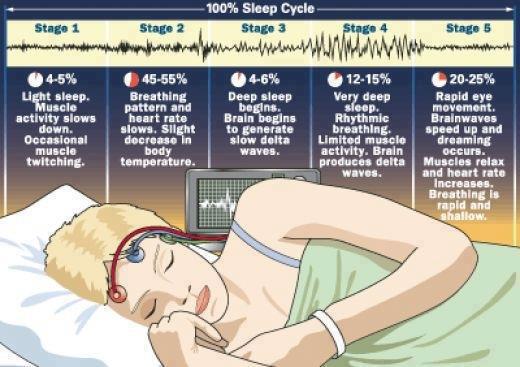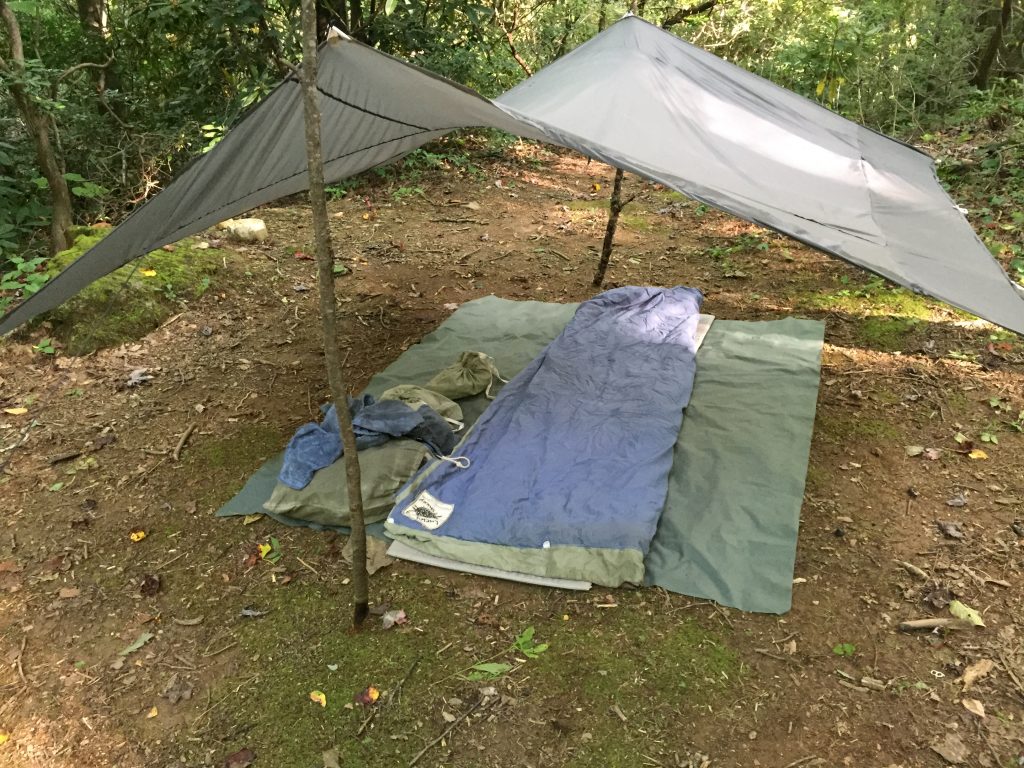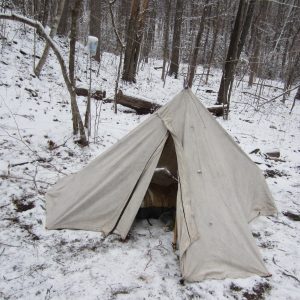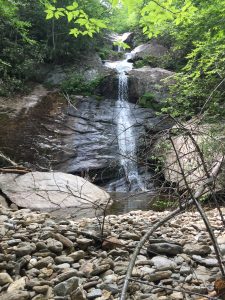When I take my friends camping they are amazed at how easy I make it look. I just whip out my gear, have the tarp up and everything organized no matter the weather, and usually fall asleep about as soon as I hit the sleeping bag. I have spent many years trying to find a way to be more comfortable outdoors. My goal was to make it feel like home. What I mean by that is that I want to feel relaxed, safe and comfortable. After all, I came to nature to get closer to my primordial existence. So wouldn’t it make sense to feel more at home?
The barriers to reaching that place are many. It has taken me years to reach my goal, which was to easily transition from indoors to outdoors as if there were not that much difference. The first step was overcoming health challenges which happened when I turned to Ancestral Health, Paleo, and Pro Thyroid approach. The second step was developing gear that allowed a natural experience of nature. And the third step was practicing and tweaking my technique.
I use my every day lifestyle to train for the outdoors. This is how I have built a badd ass outdoor body/mind ready for the rigors of the wilderness. Our over protected, over padded, over domesticated, over processed culture pushes nature out. If we design our indoor environments and lifestyles with rewilding in mind we will be halfway there before we even get to the trailhead. If we go from overheated and over cooled indoor spaces where everything is push button, surfaces are level and then suddenly we’re outside on the weekend not accustomed to uneven terrain, temperature fluxuations, bugs, sun, noise from wind…we’re probably not going to sleep well.
However, the typical approach is to bring our fear of nature with us in so many ways. We do this in several ways that sabotage our outdoor experience. We spray toxins on our skin and clothing to keep the bugs away, we zip up inside a synthetic tent which is off gassing chemicals, inside a synthetic sleeping bag and clothing also blocking our skin from breathing and keeping us from the amazing rejuvenating air renewed by the trees and moving water, cover our skin with toxic sunscreen and our eyes with circadian disrupting sunglasses. The self sabotaging practices of modern outdoor enthusiast can be easily remedied by applying rewilding principles.
Several years ago when everyone was trying to bio hack their homes for EMF protection, grounding, lighting, temperature I went the opposite direction…back to nature. I moved into a tipi which was a most extreme lifestyle experiment. It was amazingly healing to live so close to nature. I had a canvas tipi coated with beeswax and made my first wool sleeping bag. This allowed a natural flow of air which was critical for maximum comfort. I kept the ground bare dirt and placed my bed and belongings on slatted wooden frames. Then I started finding ways to bring this kind of living on my backpacking adventures. So the goal for a good outdoor experience would be homeostasis, good sleep, and predicting dangers/hazards ahead to prevent and mitigate. You know you’ve achieved this if you come back refreshed and not depleted needing time to recuperate.

1—Overcoming Fears
I spent over two years sleeping and living outside both in my tipi and on wilderness excursions. During this time I developed a spiritual/psychological reset where nature became my default place to be. That means home. It also required me find a way to be at home in different locations…like a nomad. I used breath awareness and meditation to connect with my heart center and pull myself into the present moment. This was extremely useful because before I learned to do that I would be associating a place to return to as home. (See The Tipi Experiment)
What I noticed is my relationship with the forest changed. Suddenly I was noticing things I hadn’t before. The main thing was I felt a kinship with animals and plants and even the earth and weather. I could feel the aliveness of the forest. It wasn’t a boring bedroom with four walls and total predictability. In the wilderness things are in constant flux, like weather, day/night cycle, animals, terrain. The ground is uneven. There is no furniture other than the occasional boulder the perfect shape for a chair or something. There is not some big building to protect from temperature and weather extremes. Also it is pretty easy to have unpleasant things happen like sunburn, bug bits, bruises, sprains, poison ivy, or hypothermia or simply anxiety from fear of the dark or things that go bump in the night.
Anyone can overcome the fears of being vulnerable in nature. It mostly takes practice and it helps to have someone with experience show you the way. Find friends or join a Meetup hiking club.
2—Cultivate a Relationship with the Animals, Plants, Earth, Weather
I have had many nights of animal encounters such as deers, owls, coyotes, foxes and even frogs. (Yes; one night sleeping near a stream some frogs jumped on top of me as they were making their way back to the water). I do keep my food properly tied up high on a tree limb. But even without food, animals are moving around in the night. And I sleep either in an open tarp or under the open sky. What I found out is the animals actually give me space and in general are not a threat. After so many encounters I now relax around the whole teaming wilderness and feel like my space is respected. I feel like I earned this respect by dropping my fear. This happened by me facing my fears and challenging them one by one. Us humans don’t realize how we live our lives in pretense. We hide behind our machines, appearance, identity, accomplishments, buildings. We live our lives through our egos. There is no way to see this until we step outside.
Many years ago I was in a near death experienced, lost on Black Dome…the highest mountain of the East Coast at night in October, and survived by piling up some leaves to crawl under. After that I was humbled to feel how little I am in the eyes of the mountain…and nature.
In the beginning it was really scary to be walking through the forest at night. It seemed like a thousand eyes were watching my every move. And actually there probably were and are. Out there, you can hide nothing. In nature is where truth has no barriers. Your thoughts become amplified and you see your life clearly and perhaps that is the biggest fear of all…the fear of being alone.
One night I was sleeping on a trail and I awoke to the sound of a lady screaming in distress. It wasn’t the first time and I knew it was a fox and it seemed pretty far away. But in 30 seconds it made another scream noise and it was getting closer. I wondered what was going to happen because it was obviously going down the trail that I was on and probably didn’t know I was there and would it run right into me? Suddenly it screamed within a few feet of me and I screamed back out of terror. About 30 seconds later I heard it again and it was far down the trail on the other side of me since the fox had been as frightened of me as I was of it!
Sometimes owls have appeared in the middle of the night and sometimes in a tree right above me. Owls and all animals carry messages for us so we should ask, “What do you have to tell me?” It can be extremely startling however we can learn to relax around it by knowing we are all one tribe on planet earth. Just this week an owl did the same thing. It made six calls slowly and spaced out. Haunting, eery, and left me wondering…the number six. Does that mean something will happen in six days, six weeks, six months?
Many nights I have woken up to coyotes. Sometimes they are very near howling into the night and sometimes farther away. I used to know an old timer friend in Kansas who was a freight train hopping hobo. He woke up one night when he was sleeping under a bridge to a coyote licking his face. The point being, coyotes are tricksters and are not dangerous and don’t attack people. So because of that I just roll over and fall asleep although they do sound pretty heinous sometimes as they are yipping and yiping. On the other hand, I had a friend recently who had a pack of coyotes slowly surrounding her as she was camping alone. The best weapon of defense is a Syren which is a small device that emits a blinding light and noise like a syren.
I live in the Southern Appalachians which overall is forgiving and gentle and I know other lands can actually have dangers which take more precautions such as grizzlies, alligators, scorpions, tigers, etc. However this attitude can still be practiced while dealing safely with each situation based on knowledge for each locale. I would not enter a new land without doing research and knowing what to prepare for.
3) Learn and practice sleeping with a minimalist environment at home.
This means a firm surface such as the floor or a slatted wooden bedframe. Sleeping on a firm surface at home will prepare us for the transition when we venture into the wilderness.
If possible sleep on your deck or porch or tent in the yard. Keep windows open as much as possible and room as cool as possible. The best sleeping is freezing winter nights under enough layers of wool…as I found out during my tipi days…and which I still practice to this day.
The main tricks to make sleeping on a firm surface be comfortable, easy and enjoyable are:
a) When sleeping on your side, extend the bottom leg straight out and bend the knee of the top leg and extend it over the bottom leg.
b) When sleeping on your back, place a rolled up sock in the small of your back.
c) Make a pillow by placing extra clothing in your stuff sack. For side sleeping the pillow should keep your head level with your shoulder and so that the shoulder is fully extended. If no pillow then keep your bottom arm extended and your bicep becomes your pillow. For back sleeping the pillow should be adjusted smaller and placed only at your neck so you have cervical support, traction which decompresses your neck and doesn’t push the back of the head up.
I don’t believe in hammocks for night sleeping unless it is some reason such as there is no level ground or you need protection from ground crawling insects. The reason is because hammocks tend to bow the back which hampers breathing and alignment and thus compromises sleep. I also don’t like air mattresses in general. But if someone just has a special needs injury or mere preference and it makes them happy, so be it.
When backpacking I use a closed cell foam pad. Although yes this is synthetic, it is the only thing I know of to date which is really practical for outdoor adventure. In the old days they would have used a piece of tanned animal hide with fur on (which is similar to the felted wool pad).
4) Learn constructive primal movement.
Our push button society has taken the healthy movement out of our lives. There is not an opportunity to sit on the floor, squat, kneel, crawl and stretch in all the many ways we would be if we were hunting and gathering. Movement is required for us to remain healthy, flexible, resilient, strong, supple, and maintain healthy range of motion and mobility. Backpacking is a great way to bring this movement back. However it is good to have some training so you don’t carry unhealthy patterns with you. There are many schools for this and it is easy to find free instruction online even. Feldenkraise, Alexander Technique, Yoga, MovNat, Ecstatic Dance, etc. Specifically the primary primal movements we need outdoors are
a) Walking (yes walking. We don’t do this right.
b) Getting up and down to the ground (sounds simple but chances are you have no idea how to do it constructively,
c) Squatting (this is the perfect resting position and also for pooping and peeing, and
d) Laying down (It’s crazy but we can’t even do this right). This is why REWILDING is so important. We are simply reacquainting ourselves with our native birthright to be a human being under the sun.
Here’s my own video I did a few years ago. Sleeping on the Floor How and Why
5) Use Well Ventilated Tent or Tarp and Wool for Clothing and Bedding
What if your experience in nature was “as comfortable as your own bed”. It can be this way if we value quality sleep and invest in the right gear to make it work. This means primarily not zipping ourselves in a plastic tent inside a plastic sleeping bag. Rather, use a natural wool sleeping bag and a tent that allows ample air circulation or a tarp. The reason this creates the ultimate sleep is because you get maximum air to breath and to ventilate and move the insensible perspiration and condensation from dew and frost. The wool bedding and clothing allows the body to regulate temperature as the air gets colder or warmer throughout the night. When we zip ourselves up in the standard backpacking gear which is synthetic fabric, we are cutting off the body’s natural ability to maintain optimal temperature, breathing, heart rate, and brain waves. We can so easily wake up clammy, sweaty and not know why we didn’t sleep well.
I find sleeping under open sky is the ultimate. Even a tarp blocks some of the air. There is nothing like getting a super dose of oxygen and negative ions to create a sleep like nothing else. When camping in ways other than backpacking I like to use a canvas tent for optimal ventilation.
6) The best camping food is pemmican.
This is not what you find in camping stores and supermarkets selling camping foods which are grain based and processed. Here is my own video on how to make it.
This is sleep food. The reason: it builds thyroid health, good metabolism and keeps blood sugar steady. animal foods. This helps your body handle the rough and tumble world of outdoor adventure and facilitates adapting to the cold. In the tropics, it would be somewhat different using more fruits that grow there.
7) Cold adapting
If you live near a cold mountain stream, start getting in it in incrementally longer periods of time. If you are in the city use your bathtub and frozen plastic jugs of ice, or some kind of tub in your backyard. Alternatively you can simply keep your house cooler in winter and also expose yourself to the cold air when outdoors every day…so your body knows it’s winter.
8) Cover the eyes and ears:
Earplugs (silicon) and cloth (bandana) over the eyes. Since you don’t have a room or cave to block the light and sound you can create a sanctuary this is way. This is a personal preference because some people don’t like doing this for one reason or another. I find I sleep deeper and especially when there is loud crashing water nearby, wind, rain pelting my tarp, or loud crickets and cicadas. Sometimes I also practice listening to the sounds and merging with them. It can be delicious to really hear the sounds as though they are a symphony. Other times I don’t hear any sounds at all even though they are there.
9) Inclined Bed Therapy
Find the right slope no greater than 11 degrees and place your head on the uphill side. This is about six inches rise from head to toe. This actually enhances circulation and lowers the heart rate because the heart works less than when laying flat. This enhances sleep and dreaming. It is usually easy to find these slopes when in the mountains and usually easier than finding a flat spot. I also recommend created a sloped surface at home to sleep on. Not only is it better for your health and sleep but it will also condition you for your wilderness trips.
10) Choose the right campsite
a) Avoid widow makers (loose limbs or trees leaning which might fall over).
b) Look for good air circulation. This is a spot with not a lot of undergrowth. Without this the spot can be prone to mold.
c) Look for good water drainage. Not a low lying flat place that might become a pond. A slight slope is good. If you do have water flowing under your tarp tent during a heavy rain, be prepared to turn the sides of your plastic ground cloth so there is a slight wall of 3-6 inches.
d) Protect from insects. I recommend a net tent which is pitched under the tarp. Or alternatively a tent with noseeum netting. I also carry a bottle of eucalyptus and lemongrass essential oil and apply it when needed. Alternatively I carry a piece of noseeum netting and place it over my face sometimes propped with my umbrella.
e) Ultimate places to pitch a tent: waterfalls, streams, lakes. In summer I like the tops of the mountain and in winter be sure to camp in places protected from the wind.
f) Protection from EMF’s and Geopathic Stress. If you don’t feel well at a campsite it may be do to geopathic stress. This is a form of toxin which can weaken the body. Some people dowse to check on the suitability of a campsite. If you notice something and don’t know how to dowse, simply shift so somewhere nearby. Even a few feet can make a difference. Some people use EMF barrier cloth which creates a Faraday Cage draped over them. More on this in a future post.




